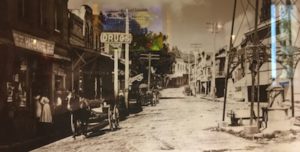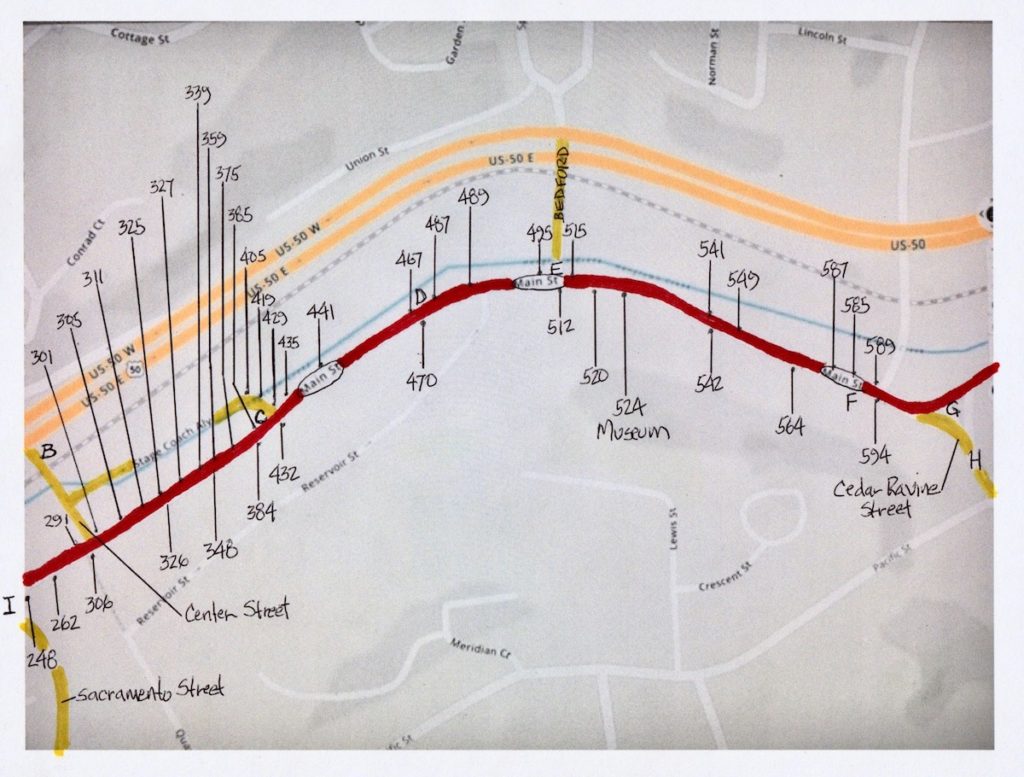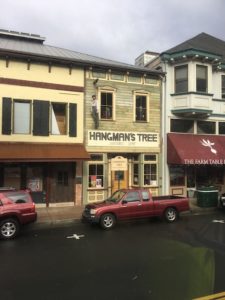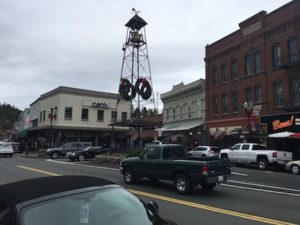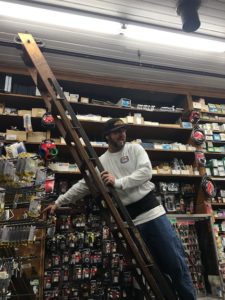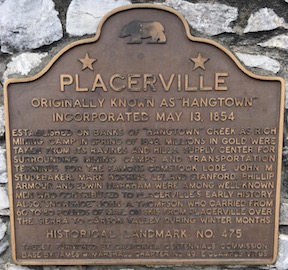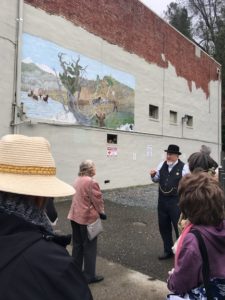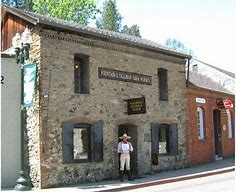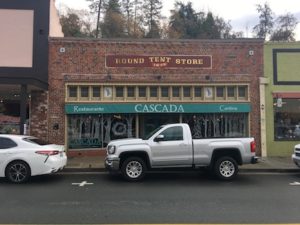Take the Spring Street exit (A) off of Highway 50, South toward Main Street. Left on to Main Street a couple of blocks to left on Center Street to the parking lot (B) behind City Hall on the right.
Placerville is in the midst of Gold Country and was an important stop for the miners and early pioneers traveling over the Sierra’s from the east to new adventures in the west. Every building in old town has a history and stories that have been well preserved by the Placerville Historical Society.
Placerville, also known as Dry Diggings or Hangtown, is just eight miles from Coloma where gold was discovered January 24, 1848 by James Marshall. At first only a mining camp in the narrow ravine with a seasonal creek, it quickly became a prosperous town, which thrived as a business shifted from mining to agriculture and logging. The name Hangtown was first used in 1849 when three men were hanged after a speedy trial. The men, originally six, robbed a stage to use the money to finance and establish the confederacy in California. The name Placerville became official when the Post Office was established in 1854. Two years later, Placerville was devastated by three separate fires, which destroyed most of the timber shacks and tents which sprung up in 1848. They rebuilt with bricks.
FYI– The fun part of this tour besides seeing all the history in Placerville is that there are many stores to shop in, especially if you are looking for clothes, jewelry, hardware, and art. And there are at least a dozen various types of restaurants to eat in.
On Center Street across from City Hall where you parked is:
Fox Lot – Early on, this same parking lot was the location of John Fox’s Blacksmith Shop. Later it was a stable and then an automobile dealership. In the northeast corner is a monument near the burial site of the three men hanged in 1849.
There are docent lead tours (530-626-0773) that can be arranged through the historical society, but you can walk it yourself. Here are the details…
The tour is divided between the North and the South sides of Main Street starting at the west end. Get back to Main Street after parking and turn left (east) to start the North side of the street walking tour.
Northside of Main Street (West to East)
301 Main – Herrick Building. This first house on the corner was built in 1853 from local bricks. Plans are underway for its restoration.
305 Main – Hanging Tree Bar. Now a registered historic landmark, this building was named for the nearby stump of the infamous Hanging Tree and housed the Hanging Tree’s Bar for many years.
Note: The name Hangtown was first used in 1849 when three men were hanged after a speedy trial at this building. The men, originally six, robbed a stage to use the money to finance and establish the confederacy in California.
311 Main – The Placer Hotel. The Hotel located here was famous for its fine cooking. James Marshall, the discoverer of gold in 1848, often stayed here when in town. It was built in 1901 by John O’Donnell who operated a store with its second floor devoted entirely to an unrivaled collection of toys, games, and sporting equipment.
325 Main – Tracy’s Shoe Store. The shoe store has been here since 1876 until 1957. H.N. Tracy kept eight workmen busy making custom boots which sold from $12 to $40 a pair. He is credited with the design and making the first right and left shoes.
327 Main – Clothing Store. Read the plaque on the building that provides an interesting history of the building. Built as a clothing store in 1855, the current store carries on the tradition.
339 Main – Combellack’s Clothing Store. Originally opened in 1888, it continues to be owned and operated by the same family.
359 Main – Log Building. In 1850 Lucy Ann Wakefield, an enterprising lady from Connecticut, bought the log building that was here and began making and selling mince pies to the miners at a reasonable price: $2.00 plain, sugared was $50 extra. She went on top become a prosperous and successful businesswoman.
375 Main – Jewelry Store. Pioneer jeweler, F.F. Baras arrived in town in 1852 and later had his store here. It is now the location of Randolph’s Jewelry, making it the oldest jewelry store west of the Mississippi River.
385 Main – Post Office. Fassett & White constructed the two story brick building in 1852 and the Post Office was located here in 1860. George Gilbert made improvements in 1870 making his second floor photography studio the most modern in town.
409 Main – Shelly Inch Building. The Placerville News Company is located here which is named for the merchant, Shelly Inch who added the second floor and cast iron façade in 1898. Originally built in 1856 as a bookstore and periodical depot, it still offers among other items, the best selection of magazines and newspapers today.
419 Main – Masonic Lodge Building. A plaque on the building provides an interesting history of the building.
Bell Tower (C)– The first Bell Tower was placed here in 1865 to alert townspeople and volunteer firemen in the event of a fire. For a short time it was located above the town on Reservoir Hill, but returned to this location in 1910 after the Court House fire. The original bell is located in the El Dorado County Museum on Placerville Drive.
429 Main – Fairchild Building. In 1849 Colonel Albert Bee and his brother Frederick built a pole and split shake store and dwelling here. The brothers helped to found the Placerville-Humboldt Telegraph Company in 1858 which ran from Placerville to the Great Salt Lake in Genoa, Nevada and was known as the “Bee’s Grapevine.” When the building was built for W.A. Fairchild in 1903, enough gold was found when digging the foundation to finance the project! It housed Fairchild’s Pharmacy, which continued when his son joined the business.
435 Main – Adams Express Company. This is where Adams Express Co. had their offices from 1852-1855. John Studebaker’s biographer related the story of Studebaker and Hinds seeing four men enter and removing heavy sacks of gold from the safe after the bank closed due to a banking panic. After alerting the sheriff who confronted the “thieves” (actually the owners of the bank) they got their gold back. At daybreak Studebaker wheeled his and Hinds money up Main Street in one of his own wheelbarrows, burying it in the dirt floor of the blacksmith shop. (See 541 Main) The present building was built after the fire in 1856.
441 Main – Placerville Hardware. Placerville Hardware in the oldest continuously operating hardware store west of the Mississippi. Go in and enjoy the atmosphere with its wooden floors, original bins, rolling ladders, and stock piled high. You can get practically anything here. Years ago the newspaper was located in the east side of the building. The presses were operated with a Pelton Water wheel in Hangtown Creek.
467 Main – Odd Fellows Building. Was built in 1911, then replaced after another fire in 1913 burned down the building next to it. There is a plaque that provides and interesting history of the building and its famous spring-loaded dance floor.
City Hall Parking Lot (D) – After the 1856 fire the hotel located here was rebuilt, before another fire destroyed it in 1913. Left as a parking lot., Placerville’s Community Pride maintains the garden and the informative historic displays were placed on the Public Restrooms by the Heritage Association. The clock stood in front of the River City Bank building 1925-1961 and placed here in 1979. Read the plaque dedicated to Deputy Sheriff Joseph Staples and about his role in the famous Bullion Bend robbery.
487 Main – Confidence Engine Company Firehouse. Was the home to a volunteer fire company started in 1860. In 1902 it became Placerville City Hall along with the adjoining building until 2004 when the City office moved to Center Street (Where you parked!)
489 Main – Jane Johnson Building. Note the plaque dedicated to Emigrant Jane Johnson, a hardy woman who drove a herd of horses west in 1859. Jane also known as Mary Jane Shroyers, purchased the lot and had this building constructed.
495 Main – El Dorado County Court House. Was completed in 1912. The earlier Court House built in 1859 on this lot, burned in 1910 along with many of the County’s early records. The two Civil War era cannons were acquired by the Grand Army of the Republic Placerville Post 103 in 1913 when the War Department made a number of surplus brass cannons available to communities.
Main & Bedford Intersection (E). Reads the Historical Landmark #475 with a plaque about Placerville’s incorporation on May 13, 1854.
515 Main – Stony Point Saloon. In the 1860’s this was the location of the Stony Point Saloon, so called because of a large point of rock jutting out of the hill just south of Main Street. In 1878 it was known as the Bedrock Saloon and advertised a free lunch. The present art deco structure was built in 1940 as the Placerville Post Office by the WPA, one of Franklin Roosevelt’s New deal programs.
541 Main – Blacksmith Shop.(See 435 Main) In 1853 blacksmith Hugh L. Hinds hired John M. Studebaker, who had come to California to find gold. Studebaker arrived in Placerville by wagon train with only $0.50. Hinds was looking for someone to help him in his blacksmith shop. Studebaker had experience with his family business in building wagons and needed money because he had been conned out of his traveling money during the trip. Studebaker quickly discovered that he could make more money constructing and selling wheelbarrows to the miners. Each would hold three sacks instead of the miners carrying one at a time. He returned to South Bend, Indiana in 1858 with his fortune and invested in the family wagon business, which later became the Studebaker Automobile Company. John returned to Placerville for a visit in 1912 when he was honored by the entire town.
549 Main – Town Hall. Town Hall was originally built as the Purity Grocery Store. In 1968, the County Library’s Main Branch was located here, until it moved into its current facility on Fair Lane in 1975. Placerville’s City Council meets here on the first and third Tuesday at 7:00 PM.
589, 585, & 577 Main – Three residences. These three wood buildings were originally constructed as residences, at a time when much of Main Street was a mix of residences and businesses.
Ivy House Parking Lot (F) – Cross Main Street to the site of the Ivy House, a luxurious hotel so named for the ivy façade. Constructed in 1864, it also housed the prestigious Placerville Academy from 1871-1894. The Ivy House was demolished in 1964 when it was deemed unsafe. If you walk to the back of the parking lot, you will see the entrance to the Ivy House park, a lovely creek side park using the native landscaping and maintained by Community Pride.
SOUTH side of Main Street (East to West)
Main Street and Cedar Ravine Street Intersection (G) – Located in the middle of the intersection, the Druid Monument (G)was erected in 1926. Druids were one of several fraternal organizations, which enjoyed great popularity in the 19thcentury. The first Druid Grove in California was created here. The plaque reads: The Druids of California Erected this Monument to Fredrick Sieg who instituted the Order in this State AD 1859, presented to the City of Placerville September 5, 1926.
Now cross Cedar Ravine to C & H Motor Parts. This was the location of the Federated Church, a fine brick structure built in 1861 as the Methodist Episcopal Church. It was demolished in the 1960’s after a new church was built on the bluff above this intersection. The first Methodist Church, a small wooden structure built in 1851, had been lovingly restored and moved to the grounds of the newest church on Thompson Way. (Down Cedar Ravine Street) The 1861 church’s magnificent Pipe Organ was donated to the El Dorado County Historical Society and is now located in a building at the County Fair Grounds on Placerville Drive.
Cedar Ravine Street (H) – If you want to extend your tour, you may proceed down Cedar Street where a number of Victorian House have been restored such as the Comebellack-Blair House, formally the residence of a successful merchant family (See 339 Main Street)
549 Main – Pearson’s Soda Works. The building was built in 1859 by John Pearson in front of a tunnel, which was used to store ice and soda in the days before refrigeration. The second story and a hydraulic lift were added in 1879 by his son.
564 Main – Tortilla Flats parking lot. What is now Tortilla Flats Restaurant was the location of Huge L. Hinds Wagon Shop in 1853. It stood across from the blacksmith shop, where John M. Studebaker manufactured wheelbarrows (See 541 Main). Also, look for the original Lincoln Highway marker imbedded in the fron wall of the building. The Lincoln Highway was established in 1912 by a group promoting paved transcontinental highway system and so Main Street was Highway 50 until 1955 when the new highway was built.
542 Main – Kossuth House. Now the El Dorado Chamber of Commerce, it was the location of the Kossuth House. In 1853 the advertisement for it read hotel supplied with dining room, bar room, and sleeping apartments, large kitchens with never failing spring within, large store room connected with the hotel and a large barn and stable ward within the premises. The current building was built by the County as the Veteran’s Memorial Building in 1923. The County Chamber of Commerce has been here since 1972.
524 Main – The Fountain & Tallman Museum. Is in this historic Soda Works Building. Constructed in 1852 out of local materials, a fresh water spring in the hillside behind it was bottled and sold to miners. It survived the fires of 1856 because of its stone construction. Owned by the El Dorado County Historical Society, it is open Wednesday-Sunday, 11:00 am-4:00 pm with exhibits on the early days of old Placerville as a gold rush mining town and many of the businesses mentioned in the walking tour.
520 Main – PG&E Building. Built in the 1920’s by Pacific Gas and Electric to compliment the 1852 Fountain & Tallman Soda Works Building next door. These two remaining buildings, along with two additional neighboring buildings, which have since been replaced, were described as PG & E’s Pioneer Service Group when they had their offices and storage here on Main Street in the middle part of their 20thCentury.
512 Main – Presbyterian Church. Now the Round Table Pizza and parking lot, the Presbyterian Church once stood here and was one of the largest and handsomest in the foothills. A long grassy lawn ran up the hill bordered by a row of giant poplars.
470 Main – Michigan Boarding House. This was the location for the Michigan Tavern in 1852 and a year later Daniel Gridley opened the Michigan Boarding House, which provided cramped but welcome sleeping quarters to miners and travelers. It was the first home of the Confederate Engine Company, a volunteer fire company, until 1860 when they moved into their new building across the street. (See 487 Main)
432 Main – Empire Theatre. In 1850 the Empire Theatre was one of the first and best known landmarks in Hangtown. John O’Donnell and his partner C.B.M. Russell enlarged the original building and supplied the miners with clean good rooms, good food, a 10 pin alley, a billiard room and bar, as well as stage plays. Lost in the 1856 fire, it was replaced by the Placerville Theatre. With a capacity of 1500, its furnishings were comparable with any San Francisco theater of its day. The present building was completed in 1930 and now known as Empire Antiques.
384 Main – Round Tent Store. The Round Tent Store , literally a large round canvas tent was established in 1950 by Jacob Bernstein and Emmanuel Bloomingdale to sell clothing. It burned down in the 1856 fire and was replaced by a handsome brick structure with a rounded façade, which sat far out into main Street. In 1828 the city widened Main Street and the Round Tent was moved back 17 feet to match the other buildings.
348 Main – Vantines Bathing Saloon. In 1859, the J, Vantines Bathing saloon was here doing its bit to clean up the town.
326 Main – Blue Bell Café. Now the Bookery, this building once housed the Blue bell café and was famous for its “Hangtown Fry,” a concoction of eggs, oysters, and bacon made from a gold rush recipe. Earlier it was where Ben Nickerson arrived in 1849 leading a grizzly bear and a donkey in order to stage fights. Public opinion forced him to look for a new business, so he erected a huge canvas tent gambling hall and did so well that he built a two story building with a Piazza in 1852. He called it the Union Hotel which had 75 sleeping rooms, two parlors and a 10-pin bowling alley. All was lost in one of the fires of 1856.
300 Main – Cary Hotel. The Cary Hotel was built in 1857. In 1915 John Raffeto replaced it with the Hotel Placerville and after a 1926 remodeling, called it Raffles Hotel. The fourth story was added in 1931. In 1978 new owners changed the name back to the Cary House Hotel. At one time it housed the Wells Fargo Office and served as a stage stop. Imagine amounts of gold and silver, as well as famous people who alighted here! We know Horace Greely on his presidential campaign, gave a speech from the Cary House Hotel balcony in 1859.
262 Main – Boomerang Gambling Hall and Saloon. Now the Thomas Kinkade gallery, it was gambling hall and saloon called the Boomerang in 1849. After the 1856 fire in became the Knickerbocker. In Later years it would house Dillinger’s Furniture Store and mortuary.
248 Main – Hotel Reunion de Francias. This building (with mural of Snowshoe Thompson) was the hotel Renion de Francias in 1851. In 1853 the present brick building was constructed with a flat roof and hydraulic cement to create a reservoir for water. This was the location of the Post Office in 1856 where Snowshoe Thompson picked up and delivered mail.
Main Street & Sacramento Street intersection (I). On the southwest corner, there are two historic markers. One commemorates the Pony Express Station, which was located where we now see the Fire Station and parking lot. Known as the Pioneer Stage Co., it served the legendary Pony Express (1860-1861) and then later it was the main stagecoach stop for Placerville. The other marker honors Snowshoe Thompson’s famous treks across the Sierra winter to deliver the mail between Placerville and Genoa, Nevada from 1856 to 1876.
You have now completed the Old Town tour loop and are back to near where you started.
More Information
This information was garnered from the FREE Placerville Historical Society Walking Tour brochure and by an Elk Grove Historical Society bus trip in December 2018. The brochure has great information but for me it was confusing to figure out where you were at times. There is more room on this site for the information and hopefully this guide is more helpful.
After touring old town Placerville with our historical society guide, the tour left us all wanting to come back and re-experience more of the history of this famous gold mining community and do some shopping. Don’t forget to watch your time to eat at the California Kitchen!
On this site, if you go back to the menu on the right on the Home page and scroll down past “Historic Topics” and click-on “Photo Gallery,” find bus tours and look for Placerville – Tallman-Fountain bus tour to see many more photos.

